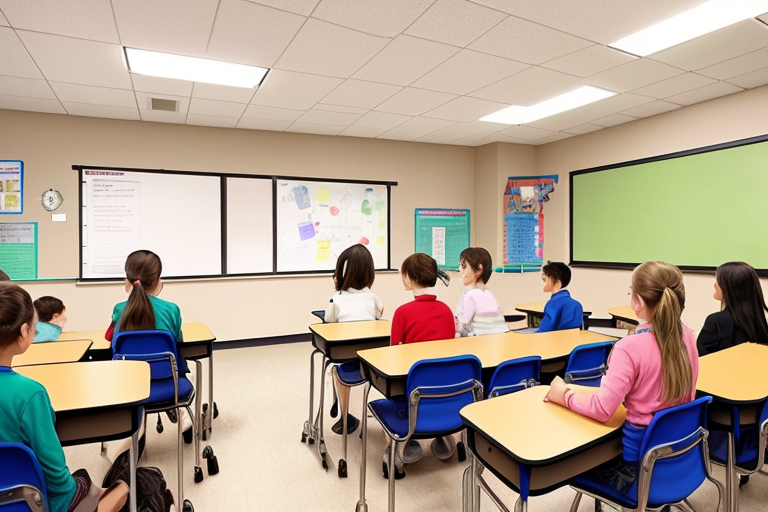Learning by Doing: The Power of Hands-On Education
Education is the foundation of our society, providing individuals with the knowledge and skills necessary to succeed in life. From a young age, we are taught the importance of education and the impact it can have on our future. However, traditional classroom learning can often be dry and unengaging, leading to a lack of interest and motivation among students. This is where hands-on learning comes in, providing a dynamic and interactive approach to education that can transform the classroom experience.
Hands-on learning is a teaching method that involves students actively participating in their own learning through physical activities and experiments. This approach allows students to engage with the material in a more meaningful way, promoting critical thinking and problem-solving skills. By providing a more interactive and engaging learning experience, hands-on learning can help students to better understand and retain information.
In recent years, there has been a growing body of research supporting the benefits of hands-on learning in the classroom. Studies have shown that students who engage in hands-on activities have higher levels of engagement, motivation, and interest in the material. This approach has also been found to improve student performance and retention of information.
So, what are some examples of hands-on projects that can be implemented in the classroom? From science experiments to art projects, there are countless ways to incorporate hands-on learning into the curriculum. For example, students can conduct experiments to learn about the properties of different materials or create art projects to explore different cultures and historical periods. By providing students with these opportunities to engage with the material in a more interactive way, teachers can help to foster a love of learning that will stay with students for years to come.
But how can teachers effectively prepare and execute these hands-on projects in their classrooms? In the following sections, we will explore the benefits of hands-on learning in more detail, providing specific examples of projects that can be implemented and offering tips for effective execution. By the end of this article, we hope to have convinced you of the power of hands-on learning and provided you with the tools to incorporate this approach into your own classroom.
Engaging Students: The Benefits of Hands-On Learning in the Classroom
As educators, we all want our students to be engaged and excited about learning. However, traditional classroom settings can often leave students feeling bored and disengaged. This is where hands-on learning comes in. By allowing students to actively participate in their own learning, hands-on projects can increase engagement and improve overall academic performance.
Research has shown that hands-on learning can be particularly effective in science, technology, engineering, and math (STEM) subjects. In fact, a study by the National Science Foundation found that students who participated in hands-on science projects scored higher on standardized tests than those who did not.
But the benefits of hands-on learning aren’t limited to STEM subjects. In fact, hands-on projects can be implemented in any subject area. For example, a history teacher might have students create a museum exhibit on a particular time period, or an English teacher might have students act out a scene from a play.
One example of the benefits of hands-on learning comes from a student named Frankie. Frankie was struggling in a traditional classroom setting until his teacher, Uvanni, implemented hands-on learning. By allowing Frankie to actively participate in his own learning, Uvanni was able to increase Frankie’s engagement and improve his academic performance.
In addition to increasing engagement, hands-on learning can also aid in information retention. When students are actively involved in their own learning, they are more likely to remember what they have learned. This is because hands-on projects allow students to make connections between what they are learning and the real world.
A judge who has spoken about the importance of hands-on learning in reducing recidivism rates among youth offenders. By allowing these young people to actively participate in their own learning, they are more likely to develop the skills they need to succeed in life and avoid future involvement in the criminal justice system.
So, what are some examples of hands-on projects that can be implemented in the classroom? In science, students might conduct experiments or build models. In art, students might create their own works of art or collaborate on a mural. In social studies, students might create a mock trial or debate.
By incorporating hands-on learning into the classroom, educators can create a more engaging and effective learning environment for their students. So why not give it a try? Your students (and their academic performance) might just thank you for it.
The Benefits of Hands-On Learning for Information Retention
Hands-on learning is an effective way to help students retain information better. According to a study by the National Training Laboratories, students retain only 5% of the information presented through a lecture, while they retain 90% of the information presented through hands-on learning. This is because hands-on learning engages multiple senses, making the learning experience more memorable and enjoyable.
One example of a hands-on project that can aid in information retention is creating a model of a cell for a science class. Students can use materials such as clay, playdough, or even food to create a 3D model of a cell. This project allows students to see and touch the different parts of the cell, making it easier for them to remember the functions of each part.
Another example is creating a timeline for a history class. Students can use a long piece of paper or a whiteboard to create a timeline of important events. This project allows students to see the progression of events and how they are connected, making it easier for them to remember the sequence of events and their significance.
In a study by the University of Wisconsin-Madison, students who participated in hands-on learning activities in a physics class scored higher on a test than those who only attended lectures. The hands-on activities included building and testing a catapult and creating a rollercoaster. These activities allowed students to apply the concepts they learned in class and see the results firsthand, making it easier for them to remember the material.
Frankie, a student in Mrs. Uvanni’s science class, struggled with memorizing the different parts of a plant cell. However, when Mrs. Uvanni had her students create a 3D model of a plant cell using household items, Frankie excelled. He was able to remember the functions of each part of the cell because he had physically created it himself. This is just one example of how hands-on learning can help students who struggle with traditional learning methods.
Incorporating hands-on learning into the classroom can be as simple as creating a project that allows students to apply the concepts they have learned. For example, in an art class, students can create a painting or sculpture that represents a historical event or scientific concept. This project allows students to use their creativity while also reinforcing the information they have learned in class.
Engaging Students with Hands-On Learning
As discussed in the previous sections, hands-on learning is an effective way to engage students and aid in information retention. In this section, we will provide practical examples of hands-on projects that teachers can implement in their classrooms to make learning fun and engaging.
Science Experiments
Science experiments are a great way to incorporate hands-on learning into the classroom. They allow students to see the concepts they are learning in action and provide a fun and interactive way to learn. Here are some examples of science experiments that can be implemented in the classroom:
1. Egg Drop Experiment
The egg drop experiment is a classic science experiment that challenges students to design a contraption that will protect an egg from breaking when dropped from a height. This experiment teaches students about gravity, force, and motion.
To prepare for this experiment, teachers will need to provide materials such as eggs, straws, tape, and paper. Students will work in teams to design and build their egg protectors. Once the protectors are built, the teacher can drop them from a height and see which ones successfully protect the egg.
2. Solar System Model
Creating a solar system model is a great way to teach students about the planets and their orbits. This project can be done individually or in groups, depending on the grade level.
To prepare for this project, teachers will need to provide materials such as foam balls, paint, and string. Students will paint the foam balls to represent the planets and then string them together to create a model of the solar system.
Art Projects
Art projects are another way to incorporate hands-on learning into the classroom. They allow students to express their creativity while also learning about different art techniques and styles. Here are some examples of art projects that can be implemented in the classroom:
1. Collage
Collage is a fun and easy art project that can be done with a variety of materials. It allows students to express their creativity while also learning about composition and design.
To prepare for this project, teachers will need to provide materials such as magazines, glue, and paper. Students will cut out images from the magazines and arrange them on the paper to create a collage.
2. Clay Sculpture
Clay sculpture is a great way to teach students about three-dimensional art. It allows them to create a sculpture from scratch and learn about form and texture.
To prepare for this project, teachers will need to provide materials such as clay and sculpting tools. Students will use the clay to create a sculpture of their choice, such as an animal or a person.
Tips for Effective Implementation
To ensure that hands-on projects are effective in the classroom, teachers should follow these tips:
-
Provide clear instructions and expectations for the project
-
Allow time for students to plan and prepare their projects
-
Monitor students’ progress and provide guidance when necessary
-
Provide opportunities for students to share their projects with the class
By following these tips and implementing hands-on projects in the classroom, teachers can make learning fun and engaging for their students.
The Power of Hands-On Learning: Insights from Educators and Students
Hands-on learning has been proven to be an effective teaching method that can increase student engagement and aid in information retention. But don’t just take our word for it - let’s hear from educators and students who have experienced the benefits of hands-on learning in their own classrooms.
One teacher, Ms. Johnson, shared her thoughts on the impact of hands-on learning: “Incorporating hands-on activities in my classroom has been a game-changer. My students are more engaged and excited about learning, and they retain information better when they can see and experience it for themselves.”
Another educator, Mr. Lee, echoed these sentiments: “Hands-on learning allows students to take ownership of their education. They are more invested in the learning process when they can actively participate and see the results of their efforts.”
But it’s not just educators who recognize the value of hands-on learning - students do too. One student, Sarah, shared her experience with a hands-on project in her science class: “We did an experiment where we built a bridge out of popsicle sticks. It was so much fun, and I learned a lot about engineering and design. I still remember the concepts we learned, even months later.”
Another student, Alex, shared his thoughts on the impact of hands-on learning on his motivation to learn: “I used to dread going to math class, but when we started doing hands-on projects, I actually looked forward to it. It made the subject more interesting and helped me understand the concepts better.”
These insights from educators and students highlight the impact of hands-on learning on student engagement, motivation, and information retention. By incorporating hands-on activities in the classroom, educators can create a more dynamic and effective learning environment for their students.









